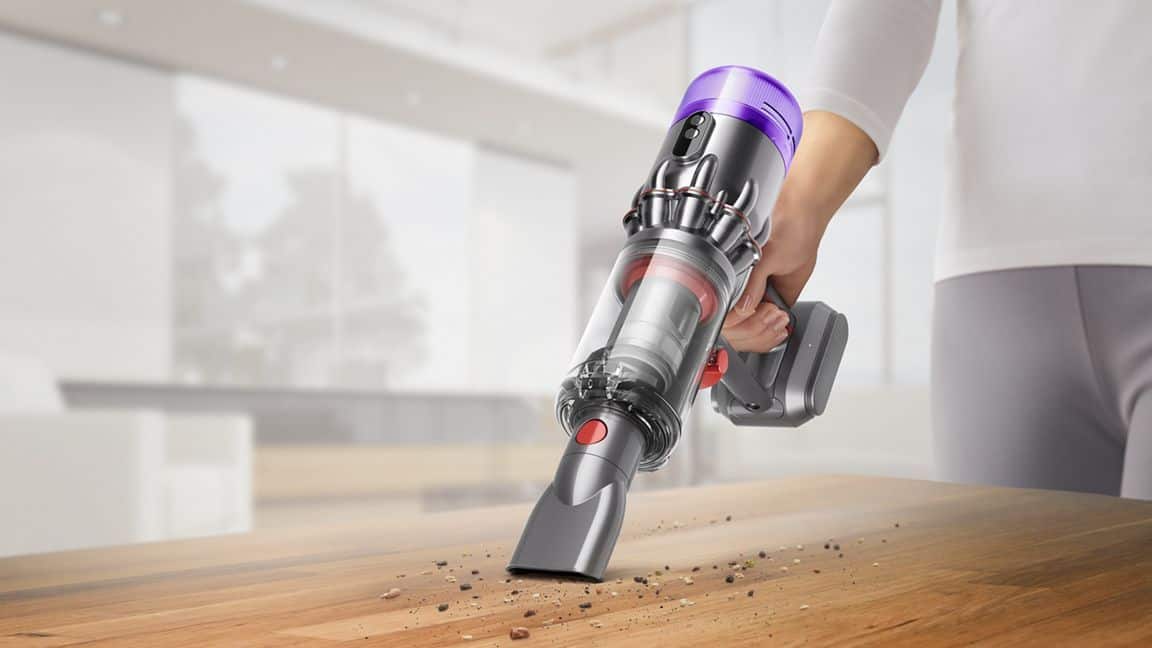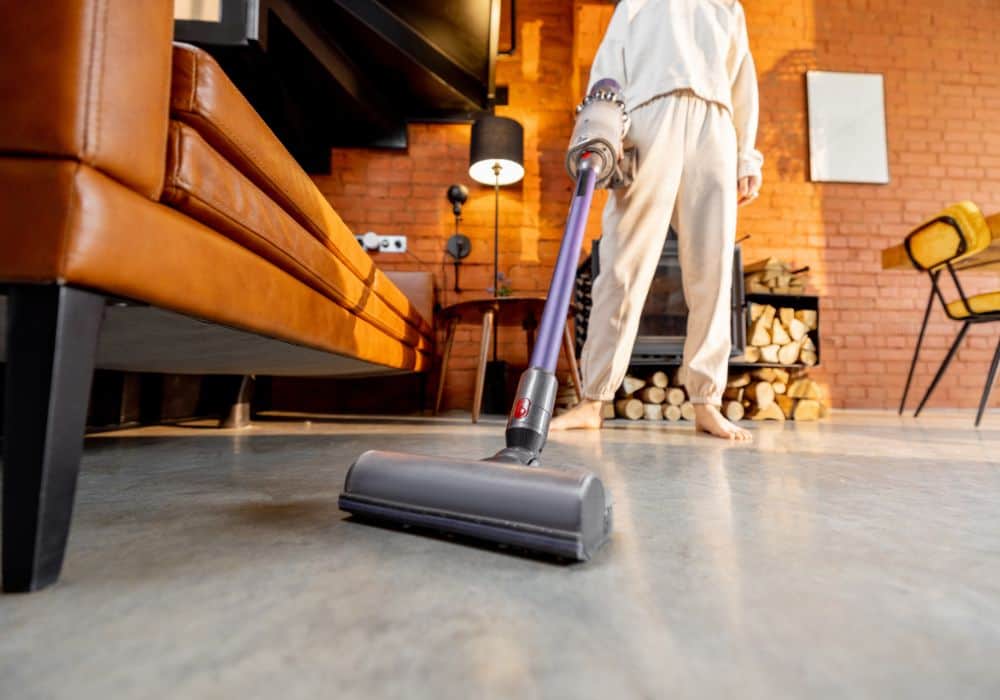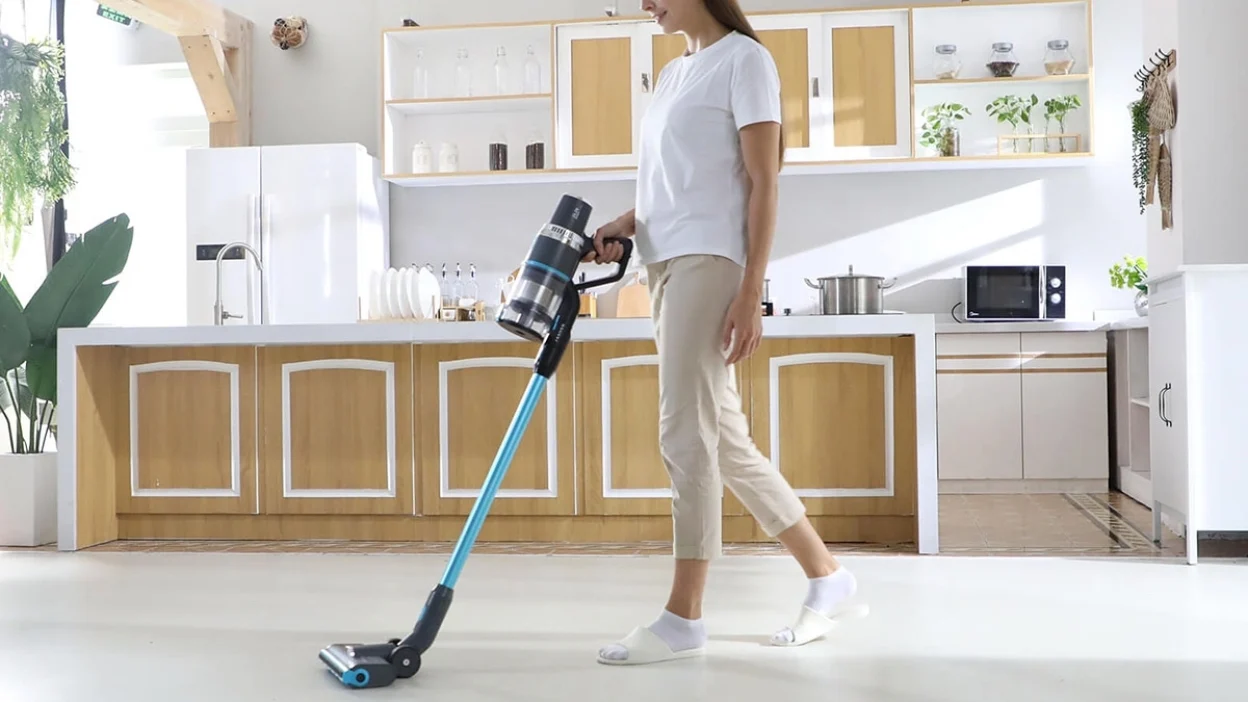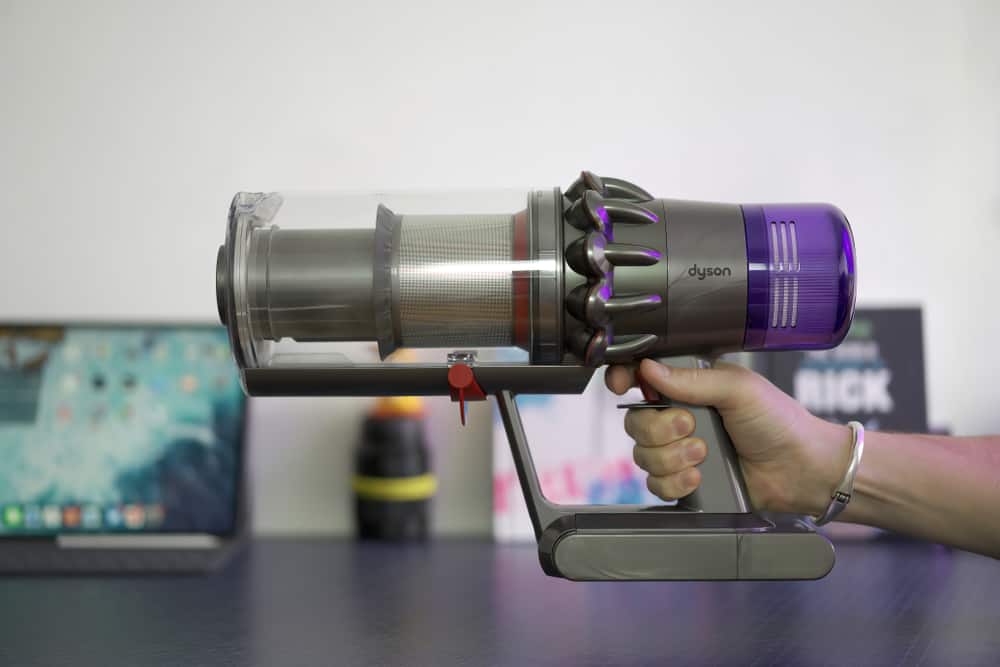We put a lot of faith in our chargers, and discovering something didn’t charge completely always throws a wrench in our plans. This is especially true with items we purchase to make life easier, such as a cordless Dyson vacuum.
In the case of your Dyson vacuum not charging, it’s usually easy to pinpoint the issue so you can resolve the issue quickly.
Keep reading as we explain how to find the root of the issue and what you should do to fix it. We also explain what you should look for if you find you need to replace your battery.
Table of Contents
Dyson Battery is Not Charging + Flashing Blue Light
The first thing to rule out is whether your Dyson battery is at fault. If you plug your cordless Dyson vacuum cleaner into the charger and see a flashing blue light, understand that the issue is not related to your battery.
A flashing blue light is normal and usually indicates that the battery is charging as normal. If the battery is not charging and flashing a blue light, instead consider:
- Problems with your outlet
- Issues with your docking station
- Problems with the charging cable or plug
- A blown fuse
Check these before you panic and purchase a whole new unit.
1. Outlet Issues
You may have used this outlet religiously to charge your cordless vacuum cleaner, but an outlet can go out at any time. Make sure you rule out an issue with your wall outlet before you start poking around in your vacuum and charger.
Plug in another device that you know works, such as a lamp, and see if it powers up in the outlet. If so, you know that the issue remains with the charger and not your home electrical system.

2. Docking Station Issues (Mounting)
This usually applies to Dyson vacuums with a mountable charging station. Many people choose not to mount the charger so they can move it around or put it away easily, but this can cause charging issues.
If this is your situation, try mounting your docking station as outlined in your manual. This should allow your charger and vacuum to make the proper connection and fix your charging issue.
3. Cable or Plug Issues
The cable or plug of your Dyson battery charger is pretty resilient, but it can only take so much. This cable will wear out over time, especially if you keep it out in high traffic areas.
Check over your plug and cable, looking out for:
- Cable stretching
- Worn insulation
- Creases in the cord
- Bent prongs on the plug
- Bite marks (from pets, children, or household pests)
If you have a compromised charging cable or plug, you need to replace your Dyson battery charger. Make sure you find a proper replacement, ideally one designed by design, to preserve the integrity of your vacuum batteries.
4. Blown Fuse
All Dyson vacuum chargers have a fuse to protect the charger from excessive currents. You can usually find the fuse panel in your plug and pop it out with a small flathead screwdriver.
A blown fuse isn’t necessarily a bad thing; it means the fuse did its job protecting your charger and vacuum from current damage.
To fix, find a suitable replacement fuse with the correct rating and insert that in the panel. This should get the charger back up and running.
Dyson Battery is Not Charging + Flashing Red Light
A flashing red light while charging usually indicates that something is wrong with the vacuum or the battery. A flashing red light is most commonly associated with an under-voltage fault.
When this happens, consider:
- Any blockages (i.e. clogged airways or filters)
- General cleaning
- A damaged or defective battery pack
You can usually diagnose the issue with some basic troubleshooting, but you may need to contact Dyson customer service in the end.
1. Blockages in Airways
Anything that impedes proper airflow of your battery may trigger an alert that you should deal with promptly.
Some blockages are easy to detect. If you suck up a sock while vacuuming, you’ll hear a sharp change in airflow and experience a reduction in performance.
Other blockages are more difficult to pinpoint. If you have pets, your vacuum may suck up fur perfectly fine for months before randomly clogging. It may let enough air through to keep working, but will still convey the issue.
Make sure you check these areas:
- Wand
- Hose
- Dust canister
You should also clean out your Dyson vacuum filters regularly (ideally every time you use your vacuum or empty your dust canister). If the filter clogs, the vacuum will not get the air it needs to operate.
2. Vacuum Needs Cleaning
Regular cleaning helps you avoid those clogs and prevents a buildup of dirt, dust, or debris on essential components.
This process includes:
- Removing and cleaning filters
- Emptying your debris bin
- Cleaning your vacuum head
- Cleaning your vacuum line
- Reassembling vacuum
When you do this, make sure you check all the parts for any damage or deeper cleaning requirements. You can purchase special tools to help with disassembly and deeper cleaning.
3. Damaged or Defective Battery Pack

Inspect your Dyson vacuum battery for any obvious signs of damage to the battery casing.
Older cordless Dyson vacuums have a removable battery pack in the handle of the machine, but newer packs (V10 and onward) require a screwdriver to access the battery.
Check your battery casing for any signs of damage, such as:
- Cracks
- Dents
- Chips
Even damage that appears insignificant may require replacement for safety and performance reasons.
Dyson Battery Not Charging on Arrival
If your Dyson battery arrives completely dead or will not charge completely, you’ve likely received a defective battery.
Lithium-ion batteries cannot be shipped with a full charge, and your user manual tells you how long you need to charge the battery before you can use your vacuum. If you exceed this time with no change in the charge level, it’s time to contact the retailer or Dyson customer support.
In most cases, the retailer will replace the unit as long as it’s in the same condition it was sent in and you have proof of your purchase. These batteries may sit in a retailer’s storage location for too long, effectively killing the battery.
If the retailer will not help you, simply contact Dyson and let them know what’s going on. They will review any warranty information and your purchase arrangement to help you solve the problem.
Signs You Need a New Battery
There are usually other signs when you need to find a suitable battery replacement for your cordless Dyson vacuum.
Dyson batteries only last a few years (although newer models claim a much longer lifespan). If your battery has outlived its expected lifespan or your vacuum performance is slacking, consider purchasing a new battery.
1. Reached End of Expected Lifespan
Dyson V6 through V9 models have an expected battery lifespan of about 3 years, but some can last as many as 5 years. This varies depending on how frequently you use the vacuum and how well you maintain the battery.
Newer cordless Dyson vacuum models can last as long as 15 years with proper care, meaning no one with a V10 or V11 should need a replacement yet.
Understand that all batteries degrade over time, even if you take perfect care of them. If your battery is around the end of its life, it’s a good idea to have a replacement around (even if it’s working fine).
2. Decreased Performance
Dyson batteries lose performance as they age, but it isn’t usually a problem until they reach the end of their term.
To test your battery:
- Allow it to charge completely
- Set your cordless vacuum to “Max Power”
- Run a stopwatch while timing how long your vacuum runs off that charge
A Dyson battery should allow the vacuum to run 6 minutes off a full charge, but anything between 3 minutes and 6 minutes is usually acceptable. When your vacuum falls below 3 minutes, it’s time to replace the battery.
Official Dyson Batteries vs Off-Brand Replacements
While official Dyson batteries cost more than off-brand replacements, they are well worth the investment.
Official batteries offer:
- Better build quality and safety
- Better performance
- Longer life
For these reasons, you usually save money in the long term with an official Dyson battery replacement.

Overall Quality and Safety
Dyson works with Murata to produce high quality and rigorously tested batteries for your cordless vacuum. While they’re more expensive, the cost of creating a reliable lithium-ion battery is greater than pushing out low quality products.
Generic battery cells usually cost less because they didn’t go through testing and do not have safety measures in place to prevent issues like overcharging or overheating. They use cheaper materials that don’t hold up well over time or under pressure.
Performance
While most third party battery replacements work fine to start, there’s a noticeable decrease in performance around the year mark (sometimes sooner).
A Dyson battery is more likely to hold its charge and offer the power needed to clean your home.
Capacity and Longevity
Unmarked batteries usually have a lower capacity than a Dyson battery, and they may only last 5 minutes off a full charge to start. Even batteries that claim to last longer than an official battery don’t hold true to their word.
It’s around this year mark that most of these cheaper batteries start to fail completely, meaning they only last ⅓ as long as the official battery replacement. When combined with their affinity to fail from a small drop, you don’t get much time with them.
Conclusion
A cordless vacuum is undoubtedly convenient, but it can be a main source of stress when things go wrong. If you run into this problem, remember to:
- Verify your outlet isn’t the issue
- Check your charging cable and plug for damage
- Check your charger fuse
- Clean your vacuum
If you find that the battery itself is the issue, opt for the official Dyson battery replacement. You’ll get more use out of it, and you won’t need to replace it again next year.
Is your Dyson not charging? Comment with the specific problems you’re having!
